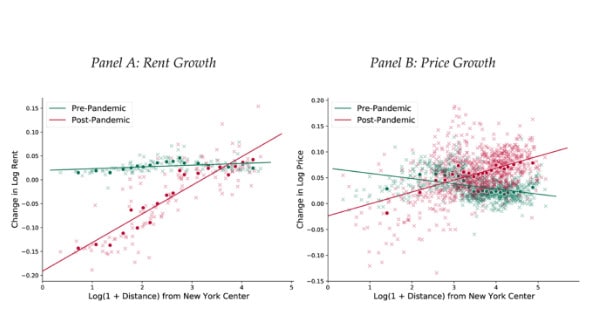- The first step is making the call.
- 1300 022 482
- hello@searchpartyproperty.com.au
How Remote Work Is Changing Real Estate Forever

As we venture further into the digital age, a seismic shift in the conventional work setup — from traditional office environments to remote settings — is reshaping the landscape of our society and, by extension, the real estate market.
In today’s article, we’re investigating a few of the defining trends at play, and discussing what they could mean for us as property investors.
1. De-Urbanisation
For centuries, the status quo of human development has been rapid urbanisation. From just 1960 to 2020, the share of the global population counted among urban areas rose from 34% to 56% – according to UN estimates.
Thus, the scale of pandemic-induced de-urbanisation is unprecedented among history and, though an emerging field of study, several datasets help to paint the picture of this pattern. Some examples are:
- One study used overnight mobile phone pings to identify net out-migration rates of 20% in areas close to city centres, while areas further from city centres experienced net in-migration. – Another study identified an obvious correlation between higher proportions of work-from-home jobs and net out-migration rates.
- Another study identified an obvious correlation between higher proportions of work-from-home jobs and net out-migration rates.
- Change of address data made available by postal services also corroborates these findings, with inner city areas demonstrating disproportionately high change of address rates.
Recent surveys also continue to bear out this pattern. According to one PwC survey of business leaders, 86% expect that this long-term shift towards remote collaboration will continue. Naturally though, questions persist regarding the permanency of pandemic-induced de-urbanisation.
2. Shifting Buyer Preferences
As we might intuitively expect, the exodus of population from high density city centres prompted a change in demand for real estate. Surveys indicate that suburbs and rural areas are experiencing a surge in demand, while demand for larger, even multifamily homes has also grown. With workers spending more time at home, improved amenities and home office spaces have become necessities. According to research, these changing preferences caused a commensurate spike in the value of properties that fulfill such criteria. Rental premiums also rose for properties beyond urban centres.

To take New York City as an example, we can observe a clear change in the relationship between distance from the city centre, and rental and property price growth pre- and post-pandemic:
Gupta et al. (2022).
Pre-pandemic, we observe relative consistency of rent growth regardless of proximity to the city, and higher price growth with higher proximity to the city. Post-pandemic, we instead observe a correlation between higher growth in both rent and price growth, and greater distances from the city.
3. Rise of the “Digital Nomad”
The advent of remote work has also given rise to the phenomenon of the “Digital Nomad” – individuals or families who are not bound by geographic location and can work from anywhere with a stable internet connection. These nomadic professionals are leveraging the flexibility of remote work to explore new cities, countries, and even continents, while continuing their professional obligations.
With the rate of digital nomads increasing 139% from 2019, mobility is having a unique impact on the real estate market, particularly in the rental sector. There’s a growing demand for fully-furnished, flexible rental options that cater to the needs of these workers. From month-to-month lease arrangements, co-living spaces, to short-term rentals in popular travel destinations, these flexible housing options are becoming more commonplace.
Moreover, this digital nomad lifestyle is influencing real estate development. New construction projects are increasingly incorporating amenities like high-speed internet, home-office spaces, and community spaces into their design to appeal to this remote workforce. Digital nomad villages are even beginning to appear in some European countries.
The once-clear boundaries between work and home, urban and rural, and even local and global, are becoming increasingly blurred because of the remote work revolution. From the de-urbanization trend to the evolution of buyer preferences, and now, the rise of the digital nomad, these are just some of the changes that are creating new patterns and opportunities in the real estate market which investors can’t afford to ignore.
As we move forward in this era of remote work, it’s clear that the real estate industry must adapt to these new dynamics. This includes reassessing traditional investment strategies, redefining what constitutes a “desirable” property, and even reimagining the function of our homes and communities.
Though this new landscape might be challenging to navigate, it also presents unique opportunities for those willing to adapt and innovate. As the real estate market continues to evolve in response to the rise of remote work, it will undoubtedly open up new avenues for investment and growth. The future of real estate, it seems, is not just about location anymore, but about flexibility, adaptability, and understanding the growing needs of the modern remote working population.
Want to discuss this further?
For expert guidance in what remote work could mean for you as a property investor, book in for a free consultation to make informed decisions, tailored to your investment goals. Don’t let affordability challenges hinder your success. Act now with Search Party Property!




